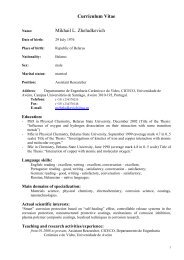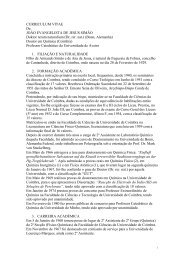XII Iberian Meeting of Electrochemistry XVI Meeting of the ...
XII Iberian Meeting of Electrochemistry XVI Meeting of the ...
XII Iberian Meeting of Electrochemistry XVI Meeting of the ...
You also want an ePaper? Increase the reach of your titles
YUMPU automatically turns print PDFs into web optimized ePapers that Google loves.
<strong>XII</strong> <strong>Iberian</strong> <strong>Meeting</strong> <strong>of</strong> <strong>Electrochemistry</strong> & <strong>XVI</strong> <strong>Meeting</strong> <strong>of</strong> <strong>the</strong> Portuguese Electrochemical Society PA 03<br />
Influence <strong>of</strong> hydrodynamic conditions on <strong>the</strong> anodic<br />
degradation <strong>of</strong> phenol on BDD<br />
S. Sobreira, L. Ciríaco, M.J. Pacheco, A. Lopes<br />
UMTP and Department <strong>of</strong> Chemistry, University <strong>of</strong> Beira Interior, 6201-001 Covilhã, Portugal<br />
analopes@ubi.pt<br />
The anodic oxidation <strong>of</strong> effluents containing organic pollutants is an alternative that has<br />
received great attention in <strong>the</strong> last years due to its interesting characteristics, since it is a<br />
clean process, can operate at low temperature and, in most cases, without adding any<br />
reagent and without sludge formation. Recently, an important development in <strong>the</strong>se<br />
processes took place with <strong>the</strong> use <strong>of</strong> boron-doped diamond (BDD) as anode material for<br />
<strong>the</strong> oxidation <strong>of</strong> all kind <strong>of</strong> organic pollutants [1].<br />
The objective <strong>of</strong> this work was to study <strong>the</strong> influence <strong>of</strong> hydrodynamic conditions on <strong>the</strong><br />
mass transfer process during <strong>the</strong> anodic oxidation <strong>of</strong> a model compound, phenol, using<br />
BDD as anode material.<br />
The electrochemical assays were performed in galvanostatic mode, at an imposed<br />
current density <strong>of</strong> 100 A m -2 . Two sets <strong>of</strong> electrochemical assays were run, using two<br />
different experimental set-ups: an electrochemical cell, with a BDD anode <strong>of</strong> 17.5 cm 2<br />
area, working in batch mode, at several stirring rates, and a DiaCel 196PVDF, with two<br />
monopol BDD electrodes, with 70 cm 2 area, working in batch with re-circulation mode,<br />
at several different flow rates. Degradation <strong>of</strong> phenol was followed by Chemical Oxygen<br />
Demand (COD) determinations, Total Organic Carbon (TOC) tests and UV-VIS<br />
spectrophotometry measurements. The experimental results have demonstrated that an<br />
increase in <strong>the</strong> stirring rate or in <strong>the</strong> recirculation flow rate leads to an increase in <strong>the</strong><br />
COD, TOC and absorbance removal rates.<br />
The obtained results have shown that <strong>the</strong> turbulence near <strong>the</strong> electrode surface is a<br />
very important parameter and its control can be used to increase <strong>the</strong> degradation rate,<br />
with equal energy consumption, thus decreasing energetic costs for <strong>the</strong> anodic oxidation<br />
<strong>of</strong> organic pollutants.<br />
Acknowledgments: The financial support <strong>of</strong> Fundação para a Ciência e a Tecnologia, F CT,<br />
PDCT/AMB/59392/2004, and Adamant Technologies are gratefully acknowledged.<br />
References<br />
[1] Panizza M.; Cerisola G. Electrochim. Acta, 2005, 51, 191.<br />
September, 811, 2010. ISEL - Lisbon 58








